This Ancho-Guajillo Paste recipe is made with ancho and guajillo chili peppers. Use it to flavor soups and stews, pasta sauces, slow cooker recipes and so much more. I have this in the refrigerator all the time as a quick go-to for massive flavor.
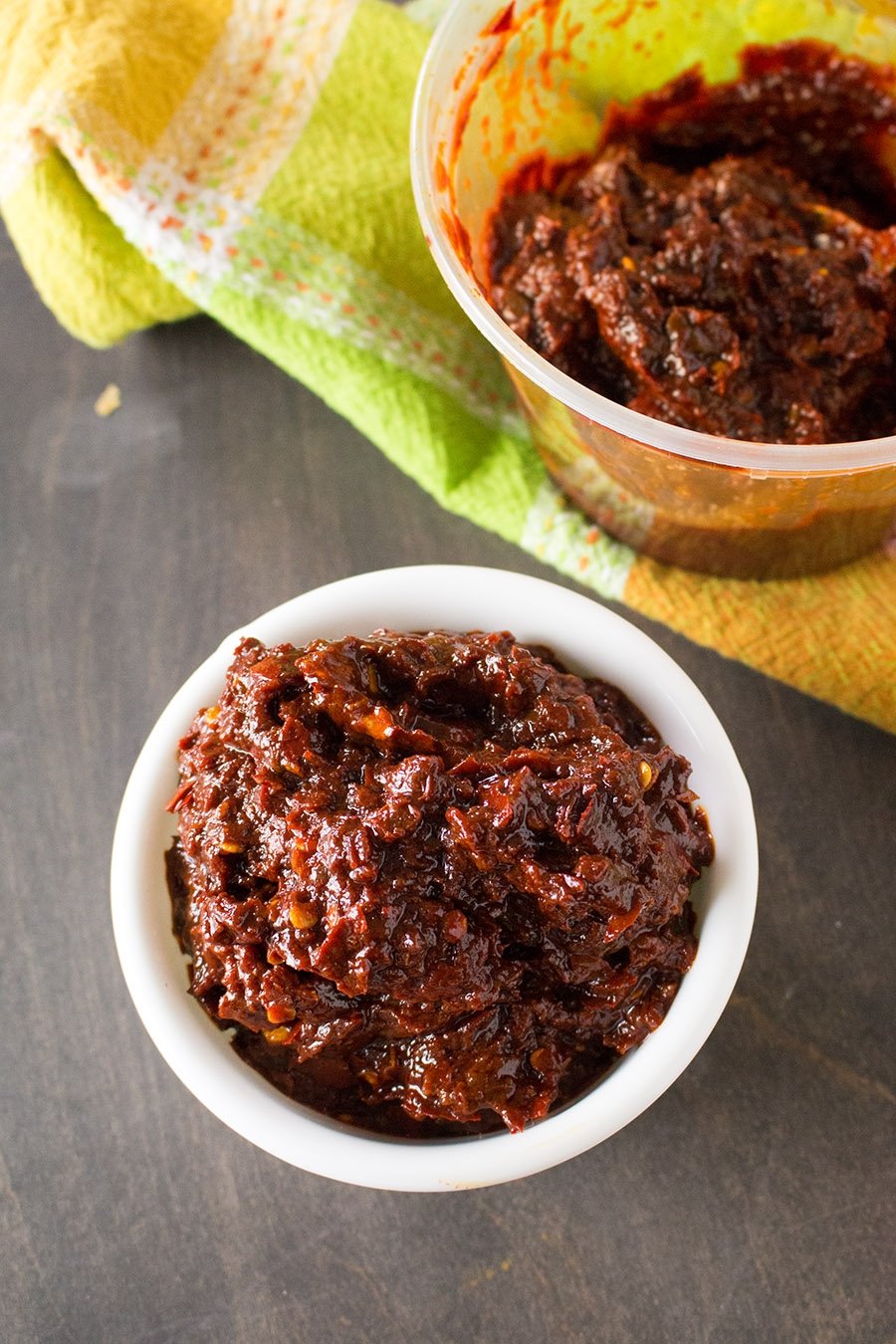
Chili pastes are essential in this wild place called the Chili Pepper Madness kitchen. A good chili paste brings a HUGE infusion of flavor to many a dish, and when I don't have a quick chili paste on hand, ready to go at a moment's notice, I chastise myself repeatedly then rush to make another batch so I can stop berating myself.
Note to self: ALWAYS keep chili paste in the house!
Recipes all around the world list chili pastes among their required ingredients. Each is made from regional chili peppers and spices, which makes the recipe flavor completely unique.
A simple chili paste is made from dried peppers. Drying the peppers preserves them, allowing you to keep them almost indefinitely.
It also concentrates the flavor of the pepper, so when you rehydrate them to make your paste, your end result is a flavor bomb that makes your body quiver.
What Type of Chili Peppers Are Used?
We grow all sorts of chili peppers each year and I dehydrate many of them for pastes alone. I can pull out a small bag of dried peppers and whip up a paste anytime I need, which is such a happy-happy thing for me.
This particular recipe is made with ancho peppers and guajillo peppers, which I picked up in bulk from my local Mexican grocer.
I keep it in a little container in the fridge, like so. Ignore the terrible handwriting.
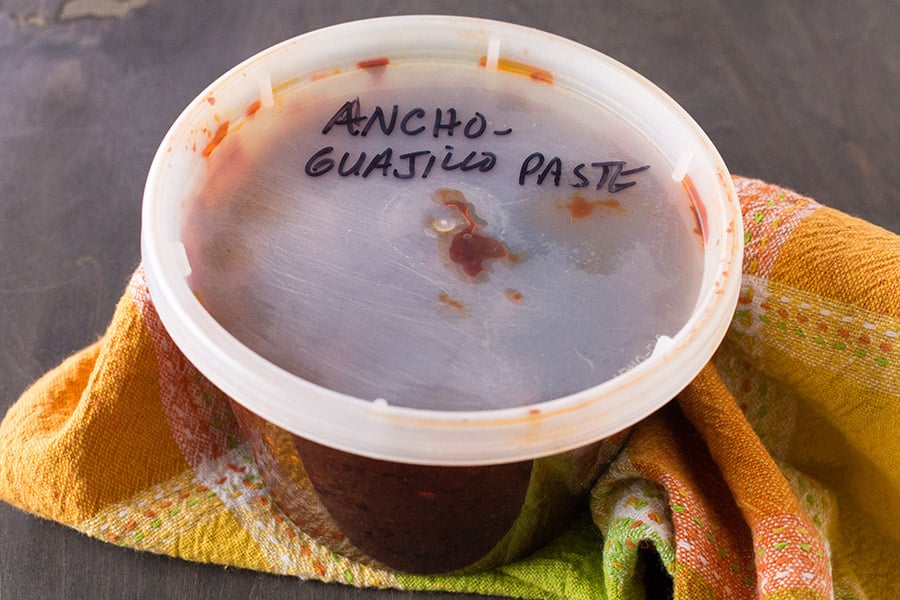
It will keep in the refrigerator a few weeks this way, or you can freeze it in small batches if you'd like.
I make a slightly larger batch to keep around for quick use, but since it's truly so quick and easy to make anyway, there is no reason you can't make a fresh batch for whatever recipe you'll be making that particular day.
I will be using this chili paste in a number of recipes that I have planned in the coming days, and I will be referencing it, so if you're cooking along with me, get a batch of this ready ahead to save yourself a bit of time.
Chili Paste
The most basic chili paste is simply rehydrated peppers that are processed and nothing else. Alone, this type of paste brings a lot of flavor to your dish.
I like to add in a few other ingredients, like garlic, a bit of salt, some onion, though you don't have to do it this way. It works for me, though.
You can add in other seasonings as well to achieve your preferred flavors, though the goal here is to keep it generic enough to be able to include it in any number of dishes.
This chili paste makes me super happy. Let me know how you wind up using it.
Ancho-Guajillo Chili Paste Ingredients
- Dried Ancho Peppers.
- Dried Guajillo Peppers.
- Olive Oil.
- Yellow Onion. Chopped.
- Garlic Cloves. Chopped.
- Salt. To taste.
Ancho-Guajillo Chili Paste - The Recipe Method
Add ancho and guajillo peppers to a large bowl and pour boiling water over them. Cover and let sit for about 20 minutes to soften.
Remove from the water (reserve the soaking water) and cut off the stems. Slice open and remove the seeds. Drop them into a food processor.
Heat a small pan to medium heat and add 1 tablespoon olive oil. Add onion and cook about 4-5 minutes to soften.
Add garlic and cook 1 more minute, stirring a bit. Remove from heat and add to the food processor.
Add a pinch of salt or so and process to form a thick paste. If it is too thick, add a tablespoon or 2 of the reserved soaking water and process to your preferred consistency.
Transfer to a container and top with a layer of olive oil.
Cover and refrigerate. Should last a couple of weeks.
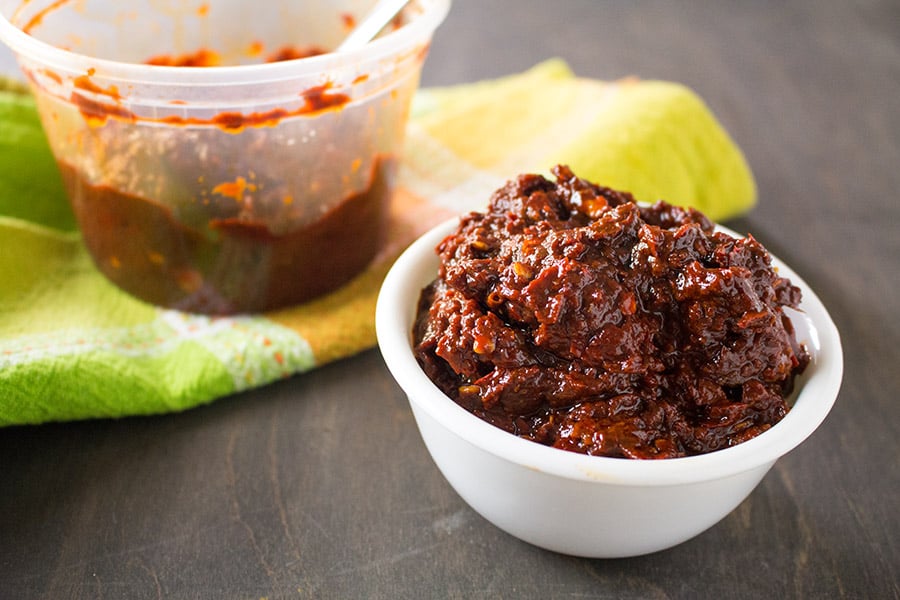
Storage & Leftovers
Storing your Ancho-Guajillo Chili Paste in an airtight container in the fridge may allow you to store the leftovers for up to 2-3 weeks. To maximize the storage life, make sure to refrigerate the paste promptly.
Recipe Tips & Notes
- What sorts of dishes can you make with chili paste? I'm glad you asked, my friends! I will be making a unique mostaccioli recipe and will use this to flavor the pasta sauce by swirling it into tomato sauce for something unique.
- Any meats you cook in the slow cooker will benefit from this paste. Think pork shoulder, lamb leg, beef roast. Toss in some of this chili paste with a bit of beer or stock and BOOM!
- Use it for soup bases that call for stocks. Asian style noodle bowl dishes are great with this. How about a good posole recipe? Oh yeah! So many ideas.
Try These Other Popular Chili Paste Recipes
- Habanero Chili Paste
- Homemade Yellow Curry Paste
- How to make Chili Paste from Fresh Peppers
- Chili Paste from Around the World
If you try this recipe, please let us know! Leave a comment, rate it and tag a photo #ChiliPepperMadness on Instagram so we can take a look. I always love to see all of your spicy inspirations. Thanks! -- Mike H.
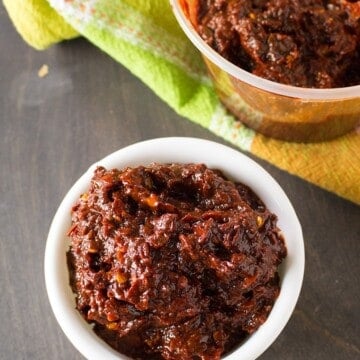
Ancho-Guajillo Chili Paste Recipe
Ingredients
Ingredients
- 8-10 dried ancho peppers (average sized, ~4-5 ounces total)
- 6-8 dried guajillo peppers (average sized, ~1-2 ounces total)
- 2 tablespoons olive oil
- 1 small yellow onion chopped
- 3-4 cloves garlic chopped
- Salt to taste
Instructions
Cooking Directions
- Add ancho and guajillo peppers to a large bowl and pour boiling water over them. Cover and let sit for about 20 minutes to soften.
- Remove from the water (reserve the soaking water) and cut off the stems. Slice open and remove the seeds. Drop them into a food processor.
- Heat a small pan to medium heat and add 1 tablespoon olive oil. Add onion and cook about 4-5 minutes to soften.
- Add garlic and cook 1 more minute, stirring a bit. Remove from heat and add to the food processor.
- Add a pinch of salt or so and process to form a thick paste. If it is too thick, add a tablespoon or 2 of the reserved soaking water and process to your preferred consistency. Discard the remaining soaking water or freeze for another use.
- Transfer to a container and top with a layer of olive oil.
- Cover and refrigerate. Should last a couple of weeks. You can also freeze it for months.
Notes
Nutrition Information

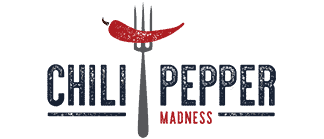

Paulette Salibury says
Hi Mike
Love this recipe but I have to admit I adjusted it. Actually I made the sauce from the ingredients in the Pozole Rojo recipe for the chili sauce by soaking the dried chilis in hot water and then blending them. Boom, done! I also added dried serranoes and jalapenos from my garden and instead of "ancho" I used some of the roasted and dried poblanos from last season. And a dollop of green tomato sauce that I put up last year from soooo many green tomatoes. So much flavor for the soup and more dishes. Thanks for sharing your brilliance!
Mike Hultquist says
Sounds like a winner to me, Paulette! Yes, BOOM! I love it.